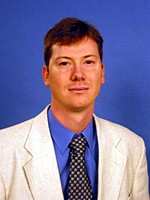Fri, Dec 17, 2004
Kudos From The National Science Foundation
 Embry-Riddle Aeronautical University
space physicist James Wanliss has received the National Science
Foundation's most prestigious award for new faculty members, the
Faculty Early Career Development award. The grant recognizes and
supports the early career-development activities of
teacher-scholars who are most likely to become the academic leaders
of the 21st century.
Embry-Riddle Aeronautical University
space physicist James Wanliss has received the National Science
Foundation's most prestigious award for new faculty members, the
Faculty Early Career Development award. The grant recognizes and
supports the early career-development activities of
teacher-scholars who are most likely to become the academic leaders
of the 21st century.
Wanliss, an assistant professor of physics at the university,
will receive $410,606 over the next five years to develop local
predictions of the effects on Earth of the magnetic storms that
originate from explosions on the Sun. Magnetic storms attack the
foundation of our planet's high-tech infrastructure, as they
interfere with and frequently damage things electrical. A storm in
March 1989 caused billions of dollars in damage.
Wanliss' team of researchers will use data gleaned from ground- and
satellite-based instruments that measure fluctuations in the
Earth's magnetic field. To those data, they will apply innovative
mathematical and statistical modeling techniques to create a system
for predicting local behavior of magnetic storms and allowing for
plans to limit damage.
 Wanliss also will develop workshops
and laboratory experiments about space science for K-12 teachers of
science and mathematics around the country.
Wanliss also will develop workshops
and laboratory experiments about space science for K-12 teachers of
science and mathematics around the country.
"We are very pleased that Dr. Wanliss has received this award
from the NSF," said John Johnson, provost and chief academic
officer at Embry-Riddle. "It reflects highly on his achievements as
a scholar and brings recognition to the university."
Before joining the Embry-Riddle faculty in 2002, Wanliss did
postdoctoral work at the Center for Data Analysis and Modeling at
the University of Alberta and was a Canadian Space Agency research
scientist working on the space weather program.
Wanliss obtained his Ph.D. in space physics at the University of
Alberta in 2000, his M.Sc. in exploration geophysics at
Witwatersrand University in 1995, and his B.Sc. (with honors) in
physics and applied mathematics at University of Cape Town in 1992.
He also has conducted space physics research at the Japanese Space
Agency and at the University of Washington, Seattle.
His previous awards include grants from the National Science
Foundation's Collaborations in Mathematical Geosciences Program and
the Florida Space Grant Consortium.
More News
From 2017 (YouTube Edition): ADS-B For Airplanes And Drones… ADS-B technology developed by uAvionix has come full circle. The company began with a device developed for manne>[...]
Dead Reckoning Dead reckoning, as applied to flying, is the navigation of an airplane solely by means of computations based on airspeed, course, heading, wind direction, and speed,>[...]
"The next great technological revolution in aviation is here. The United States will lead the way, and doing so will cement America’s status as a global leader in transportat>[...]
Aero Linx: The Mooney Mite Site Dedicated to the Mooney M-18 Mite, "The Most Personal Airplane," and to supporting Mite owners everywhere. The Mooney M-18 Mite is a single-place, l>[...]
Also: Space Command Moves, Alpine Eagle, Duffy Names Amit Kshatriya, Sikorsky-CAL FIRE Collab Textron eAviation is putting the development of its Nexus electric vertical takeoff an>[...]
 Classic Aero-TV: UAvionix - Transitioning Between Manned & Unmanned Technologies
Classic Aero-TV: UAvionix - Transitioning Between Manned & Unmanned Technologies ANN's Daily Aero-Term (09.14.25): Dead Reckoning
ANN's Daily Aero-Term (09.14.25): Dead Reckoning Aero-News: Quote of the Day (09.14.25)
Aero-News: Quote of the Day (09.14.25) ANN's Daily Aero-Linx (09.14.25)
ANN's Daily Aero-Linx (09.14.25) Airborne-NextGen 09.09.25: Textron Nixes ePlane, Joby L/D Flt, Swift Approval
Airborne-NextGen 09.09.25: Textron Nixes ePlane, Joby L/D Flt, Swift Approval




